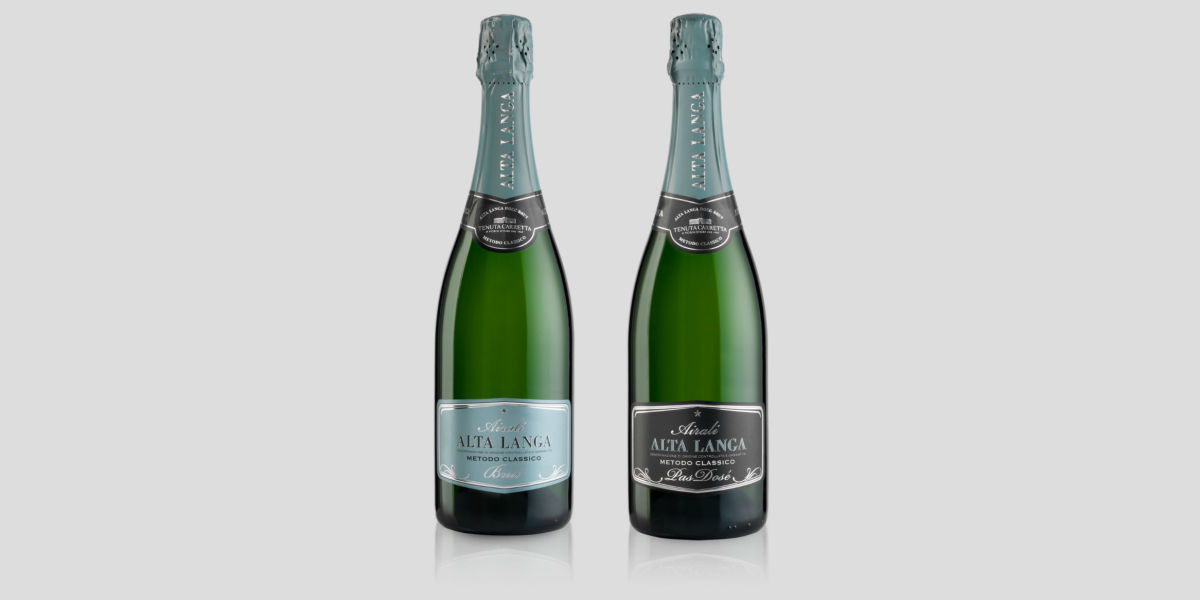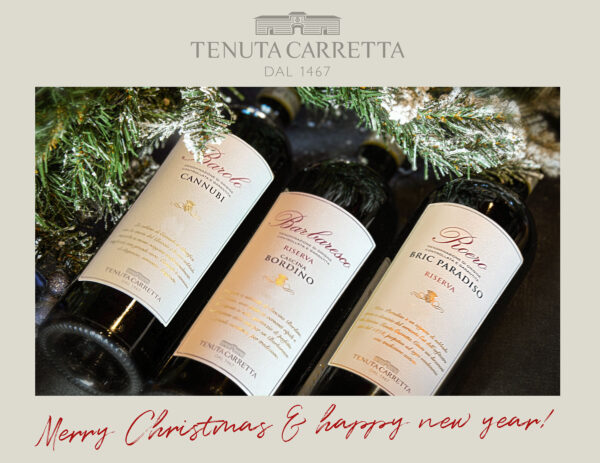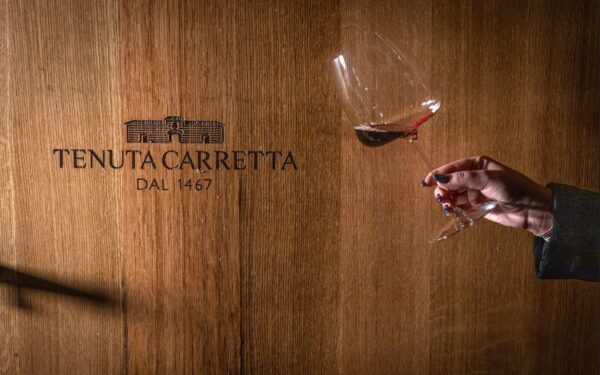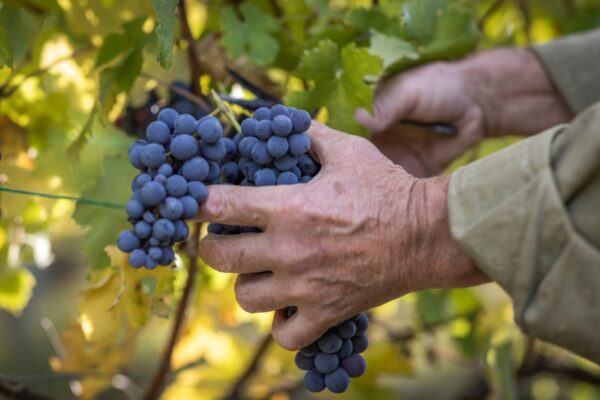• Winery, Hospitality, Wines
From Épernay to Canelli: A short story about Piedmont’s sparkling wine
Reading time in
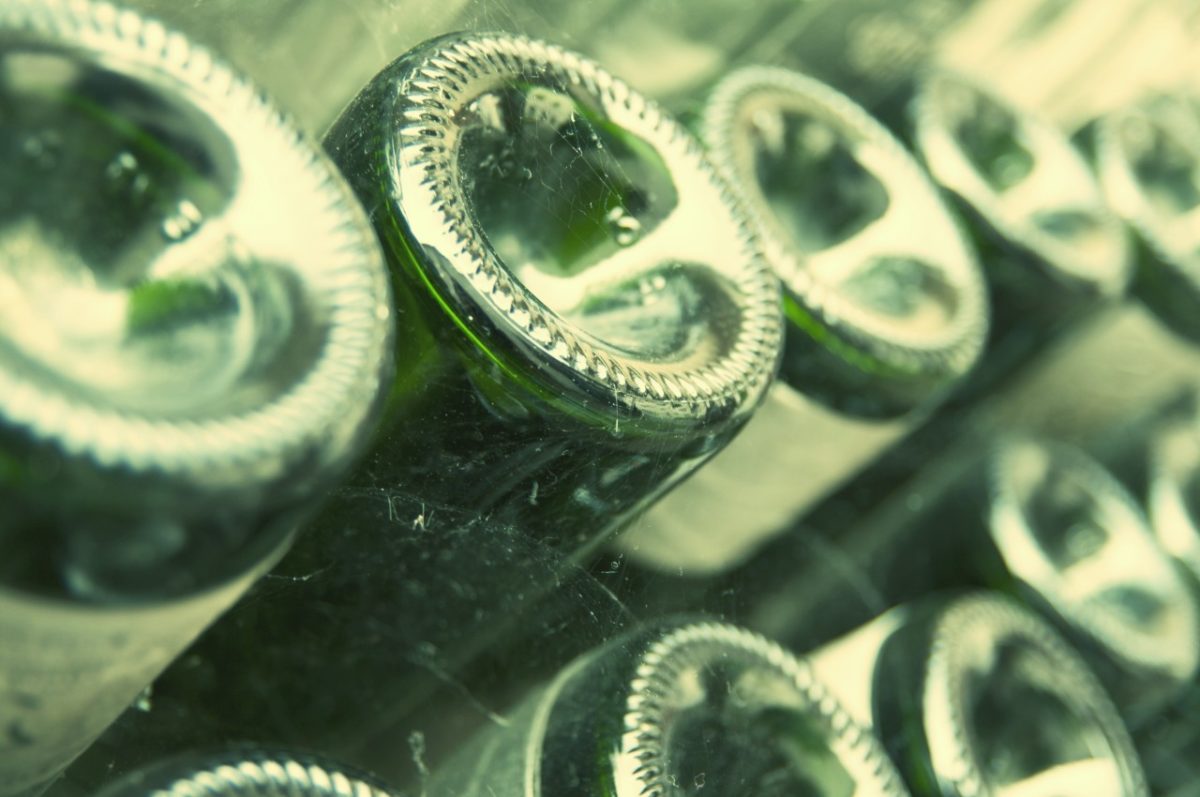
Near the end of last year, for the first time in its history, Tenuta Carretta made two sparkling wine labels. Both at Traditional Method (metodo classico) labels that fall under the “Alta Langa” appellation. But what is the Traditional Method? And when did the often-misunderstood heritage of sparkling wine in Piedmont begin? We try to answer those questions in this post.
Like all the best discoveries and inventions, what we call the Traditional Method (Metodo Classico in Italian) for making sparkling wine, was born of a mistake. It was defects in wine often found in the time of the Romans that initially spurred the advent of refermenting wine in the bottle, which over centuries, became a more refined and controllable process. Specifically, the Romans used to add honey or another sugar source to their wine, in effect, to mask off flavours. The result was a wine that was much sweeter with a higher alcohol content, and if it was then hermetically sealed, would force the carbon dioxide produced to remain in the bottle, creating bubbles.
MEDIEVAL SPARKLING WINE
Of course, no history is linear, and the sparkling winemaking practice of the Romans was ‘rediscovered’ in the Middle Ages, most especially in France and in Italy (direct descendants of the Romans). Like much else in that time period, sparkling wine went through a Renaissance, with winemakers and their patrons seeking out is curative and reinvigorating properties.
MODERN SPARKLING WINE
However, the ‘birth’ of modern sparkling wine is generally attributed to Dom Pérignon in the 18th-century in Epernay, a small town in the Champagne region of France. Legend has it, because there are no historical documents to prove this story true, that the French monk studied the local sparkling wine and then recreate it in the Abbey of Saint Pierre’s cellars until a repeatable and controllable process of was created. And so, the Traditional Method, also known as the Champenoise Method, was born.
THE TRADITIONAL METHOD IN ITALY
But what about in Italy? The first Italian Tradional Method sparkling wines were made in Piedmont at the beginning of the 19th-century. The Counts of Sambuy, influenced by their French peers, began cultivating Pinot Noir and Chardonnay, the two French varieties at the basis of sparkling wine, and started making Champagne-style sparkling wine.
Just as in France, the development of Traditional Method sparkling wine in Italy was led by a decisive figure: Carlo Gancia. He was a chemist and pharmacists, as well as the owner of a vast parcel of vineyards in Canelli. After gaining success with a new Vermouth recipe, Carlo, at the age of 19, decided to visit Reims, France to learn more about the methods of making sparkling wine. Upon his return, he and his brother, Eduardo, started Italy’s first sparkling wine house, creating the way for other local producers.
THE BIRTH OF ALTA LANGA
Producers faced a turning point in 1990, after many years of experimentation and an unclear definition of what constituted Piedmont Traditional Method sparkling wine. A few of the region’s historic sparkling wine houses signed a common commitment to enhance the quality of Pinot Noir and Chardonnay in southern Piedmont to produce high-quality sparkling wine following the principles of the Champenoise method. The commitment was known as the Progetto Spumante Metodo Classico in Piemont (Traditional Method Sparkling Wine in Piedmont Project), which was later shortened to Tradizione Spumante (Sparkling Wine Tradition) when the experimental vineyards were substantive. The grapes from the first 20 hectares managed under this new protocol went into production in 1994. Two years later, a proposal to formally regulate the production standards for these wines was undertaken. The result was the Alta Langa appellation, called as such based on the regional geography of where the wine is made: the hills that straddle the borders of the provinces of Cuneo, Asti and Alessandria.
On May 10th, 1999, the glasses were raised: a toast of the very first Metodo Classico Alta Langa sparkling wine after over 100 years of sparkling wine production in Piedmont. A centuries-old vocation finally had a name.
Verso la fine dello scorso anno, per la prima volta nella sua storia, Tenuta Carretta ha dato vita ha due etichette di Metodo Classico: Airali Brut e Airali Brut Pas Dosé.
Si tratta di due Metodo Classico piemontese, che vanno sotto la denominazione «Alta Langa». Ma che cos’è il Metodo Classico e, soprattutto, quando nasce la gloriosa, e spesso misconosciuta, tradizione dello spumante in Piemonte? Proviamo a rispondere in questo post.
—-
Come le migliori scoperte e invenzioni, anche ciò che oggi chiamiamo Metodo Classico nacque da un errore. Furono i difetti di vinificazione degli antichi Romani a causare i fenomeni di rifermentazione del vino e a sviluppare, lungo i secoli, metodi e tecnologie per produrre un vino spumante. In quel caso, la fermentazione si attivava a causa della diffusa usanza di aggiungere elementi zuccherini al vino (miele soprattutto), azione finalizzata, in realtà, a migliorarne il gusto. Il risultato era un vino più dolce e alcolico che, se chiuso ermeticamente, costringeva l’anidride carbonica a sciogliersi nel liquido, regalando l’effervescenza.
LO SPUMANTE MEDIEVALE
A partire dal Medioevo si recuperarono, soprattutto in Francia e in Italia (diretti eredi della Romanitas) vennero recuperate le antiche tecniche al fine di ottenere la spumantizzazione del vino. Se il vino effervescente era considerato di seconda categoria, è il Medioevo che cominciò a rivalutarlo, attribuendogli curativo e corroborante per il corpo.
LE BOLLICINE MODERNE
Fu però il XVIII secolo a brindare con le prime bollicine moderne. Leggenda – perché non ci sono documenti storici – vuole che fu Dom Pérignon ad “inventarle”. Abate di Saint Pierre, a nord di Épernay nella regione della Champagne, il monaco francese ottimizzò la spumantizzazione dei vini locali, razionalizzandone il metodo e rendendolo riproducibile tecnicamente: nasceva il Metoco Classico, da allora anche detto champenoise.
IL METODO CLASSICO IN ITALIA
E in Italia? Il primo Metodo Classico italiano nacque in Piemonte, all’inizio dell’800, quando i Conti di Sambuy, influenzati dalla Francia, diedero inizio alla coltivazione di alcuni vitigni francesi, Pinot Nero e Chardonnay in particolare, per produrre vini spumanti sul modello di quelli della Champagne. Anche in questo caso, lo sviluppo del Metodo Classico fu influenzato da una personalità determinante: Carlo Gancia. Chimico, farmacista e proprietario di vasti appezzamenti vitati a Canelli, dopo aver riscosso successo grazie a una nuova ricetta di Vermouth, decise, a soli 19 anni, di recarsi in Francia, a Reims, per impratichirsi nel metodo di spumantizzazione. Tornato a casa, avviò con il fratello Edoardo la prima casa spumantiera italiana, aprendo la strada dello spumante a moltissimi produttori del territorio.
NASCE L’ALTA LANGA
Dopo anni di sperimentazione e di difficile definizione del Metodo Classico piemontese, nel 1990 avviene la svolta. Alcune storiche case spumantiere decidono di sottoscrivere un impegno comune per la valorizzazione dei vitigni Pinot Nero e Chardonnay da impiegare nella produzione di vini spumanti di alta qualità, ottenuti tramite metodo champenoise. Venne ufficializzato il “Progetto Spumante Metodo Classico in Piemonte”, che prese il nome di “Tradizione Spumante” una volta che i vigneti sperimentali divennero realtà. Il frutto dei primi 20 ettari entrò in produzione nel 1994. Due anni dopo si iniziò a studiare la proposta di un disciplinare di produzione: il nome che prevalse, sulla base di ricerche territoriali e toponomastiche, fu “Alta Langa”.
Finalmente, il 10 maggio 1999 i bicchieri tintinnarono: fu il primo brindisi con le bollicine Metodo Classico Alta Langa e la prima volta che, dopo oltre 100 anni, il Piemonte rivendicava, ufficialmente, la propria vocazione alla grande spumantistica internazionale. 